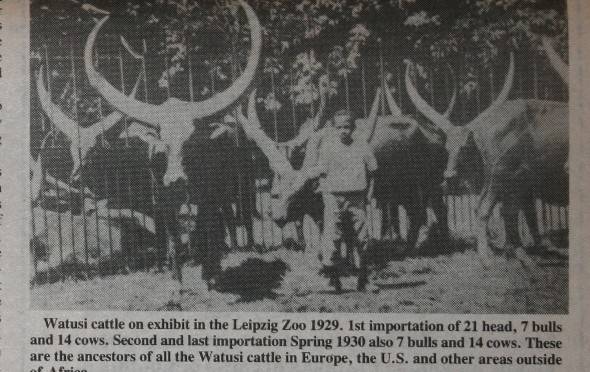EDITOR’S NOTE: In doing research on the Watusi breed, Marleen Felius of the Netherlands made an interesting discovery. We [WWA] had previously reported that the only Watusi cattle ever brought out of Africa were brought out in 1929 and 1930 by Walter Schulz and his father Christoph. Now it appears that there was one more small shipment of 6 head also brought to Germany from Africa in about 1939. The following is a copy of part of the article which appeared in the monthly journal of the Hellabrunn Zoo at Munchen, Germany dated April 1939. Reprinted with permission from Watusi World, Vol 4, Issue II.
By: Marleen Felius
Before the World War [I], the German explorer Professor D. Berger visited East Africa and the behind lying country of the Sultan of Uganda, in the source area of the Nile, between Lake Victoria and Lake Rudolf. Berger found a negro state with crowded cities from a hight standing negro architecture and a densly populated agricultural and cattle keeping country.
The Sultan still was a mighty man, even though under British colonialism. He ruled the Watusi (extremely beautiful and well trained people). When the Sultan was informed about Europe, her structures and inventions, after well listening he replied, “You white are great man, you can be proud on your possessions. But still we have something you don’t. Our pride is to possess cattle with the biggest horns possible.
[Here is some more information about cattle breeds that appeared, then another interesting story follows, the story about the quarantine period of Watusi cattle imported to Germany]
After their arrival in Hamburg, the Watussi cattle were loaded in a – for this purpose – specially adapted “Elbkahne” – a barge. This barge was moored on the wide part of the Elbe river so there was no contact with the mainland. The men taking care of the cattle during the quarantine period were not allowed to leave the barge.
Next to each Watussi animal a German one was stabled. To diagnose any possible infections t once the veterinarian of import affairs in Hamburg not just inspected the animals microscopically by blood sample tests, but also regular blood was moved over from the Watussi to the German control animals, to see if an externally sound looking Watusi did not carry a hidden illness.
If there would have turned up any form of doubt about the health of the animals, the whole herd on board the ship would have been killed and destroyed.
This risk was for the animal dealer, Hermann Ruhe of Alfeld, near Hanover. The several months lasting quarantine period, of course, was expensive. Also the long journey from Central Africa to the East Cost and from there by ship to Hamburg.
Because of the expenses one did not expect many such imports to the Zoos, they decided to breed their own and the Munchener Tierpark – Zoo procured a very fine herd of six breeding animals to breed these zoological treasures for themselves.

